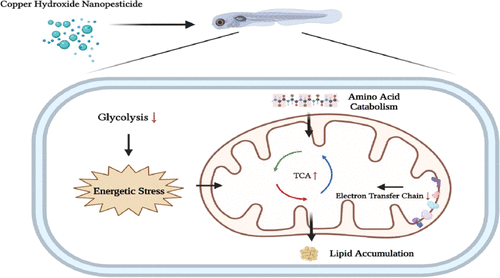当前位置:
X-MOL 学术
›
Environ. Sci. Technol.
›
论文详情
Our official English website, www.x-mol.net, welcomes your
feedback! (Note: you will need to create a separate account there.)
Comprehensive Interrogation of Metabolic and Bioenergetic Responses of Early-Staged Zebrafish (Danio rerio) to a Commercial Copper Hydroxide Nanopesticide
Environmental Science & Technology ( IF 10.8 ) Pub Date : 2021-09-23 , DOI: 10.1021/acs.est.1c04431 Xiaohong Wang 1 , Yingju Qin 1 , Xiaoyu Li 1 , Bing Yan 1 , Christopher J Martyniuk 2
Environmental Science & Technology ( IF 10.8 ) Pub Date : 2021-09-23 , DOI: 10.1021/acs.est.1c04431 Xiaohong Wang 1 , Yingju Qin 1 , Xiaoyu Li 1 , Bing Yan 1 , Christopher J Martyniuk 2
Affiliation

|
The use of copper hydroxide nanopesticide can pose exposure risks to aquatic organisms. In this study, the toxicity of a copper hydroxide nanopesticide, compared to conventional copper sulfate at environmentally relevant doses, was evaluated using metabolomics and bioenergetic assays in embryonic zebrafish. At a copper concentration of 100 μg/L, the nanopesticide caused higher mortality and deformity compared to copper ions alone; despite higher copper accumulation, increased metallothionein and elevated ATP-binding cassette (ABC) transporter activity in zebrafish exposed to copper ions were observed. Both nanopesticide and copper ions reduced the abundance of metabolites of glycolysis and induced energetic stress in zebrafish. The nanopesticide also increased concentrations of several organic acids involved in the tricarboxylic acid (TCA) cycle and elevated the activity of isocitrate dehydrogenase and α-ketoglutarate dehydrogenase, suggesting enhanced TCA cycle activity. Nanopesticide exposure depleted both glutamate and glutamine parallel to the upregulation of the TCA cycle. In addition, zebrafish exposed to the nanopesticide appeared to shift metabolism toward amino acid catabolism and lipid accumulation based upon altered expression profiles of glutaminase, glutamate dehydrogenase, fatty acid synthase, and acetyl-CoA carboxylase. Lastly, the ability of the ions to increase oxidative phosphorylation to alleviate energetic stress was reduced in the case of the nanopesticide. We hypothesize that, unlike copper ions alone, the nanopesticide induces higher toxicity to zebrafish because of increased protein catabolism. This study provides a comprehensive understanding of the risks of copper hydroxide nanopesticide exposure in relation to metabolic activity and mitochondrial function.
中文翻译:

早期斑马鱼 (Danio rerio) 对商业氢氧化铜纳米农药的代谢和生物能反应的综合研究
使用氢氧化铜纳米农药会对水生生物造成暴露风险。在这项研究中,与环境相关剂量的常规硫酸铜相比,氢氧化铜纳米农药的毒性在胚胎斑马鱼中使用代谢组学和生物能测定进行了评估。在铜浓度为 100 μg/L 时,与单独的铜离子相比,纳米农药导致更高的死亡率和畸形;尽管铜积累较高,但在暴露于铜离子的斑马鱼中观察到金属硫蛋白增加和 ATP 结合盒 (ABC) 转运蛋白活性升高。纳米农药和铜离子都降低了糖酵解代谢物的丰度,并诱导了斑马鱼的能量应激。纳米农药还增加了参与三羧酸 (TCA) 循环的几种有机酸的浓度,并提高了异柠檬酸脱氢酶和 α-酮戊二酸脱氢酶的活性,表明三羧酸循环活性增强。纳米农药暴露同时消耗了谷氨酸盐和谷氨酰胺,与 TCA 循环的上调平行。此外,基于谷氨酰胺酶、谷氨酸脱氢酶、脂肪酸合酶和乙酰辅酶A羧化酶表达谱的改变,暴露于纳米农药的斑马鱼似乎将代谢转向氨基酸分解代谢和脂质积累。最后,在纳米农药的情况下,离子增加氧化磷酸化以减轻能量压力的能力降低。我们假设,与单独的铜离子不同,由于蛋白质分解代谢增加,纳米农药对斑马鱼具有更高的毒性。本研究全面了解氢氧化铜纳米农药暴露与代谢活动和线粒体功能相关的风险。
更新日期:2021-10-06
中文翻译:

早期斑马鱼 (Danio rerio) 对商业氢氧化铜纳米农药的代谢和生物能反应的综合研究
使用氢氧化铜纳米农药会对水生生物造成暴露风险。在这项研究中,与环境相关剂量的常规硫酸铜相比,氢氧化铜纳米农药的毒性在胚胎斑马鱼中使用代谢组学和生物能测定进行了评估。在铜浓度为 100 μg/L 时,与单独的铜离子相比,纳米农药导致更高的死亡率和畸形;尽管铜积累较高,但在暴露于铜离子的斑马鱼中观察到金属硫蛋白增加和 ATP 结合盒 (ABC) 转运蛋白活性升高。纳米农药和铜离子都降低了糖酵解代谢物的丰度,并诱导了斑马鱼的能量应激。纳米农药还增加了参与三羧酸 (TCA) 循环的几种有机酸的浓度,并提高了异柠檬酸脱氢酶和 α-酮戊二酸脱氢酶的活性,表明三羧酸循环活性增强。纳米农药暴露同时消耗了谷氨酸盐和谷氨酰胺,与 TCA 循环的上调平行。此外,基于谷氨酰胺酶、谷氨酸脱氢酶、脂肪酸合酶和乙酰辅酶A羧化酶表达谱的改变,暴露于纳米农药的斑马鱼似乎将代谢转向氨基酸分解代谢和脂质积累。最后,在纳米农药的情况下,离子增加氧化磷酸化以减轻能量压力的能力降低。我们假设,与单独的铜离子不同,由于蛋白质分解代谢增加,纳米农药对斑马鱼具有更高的毒性。本研究全面了解氢氧化铜纳米农药暴露与代谢活动和线粒体功能相关的风险。











































 京公网安备 11010802027423号
京公网安备 11010802027423号